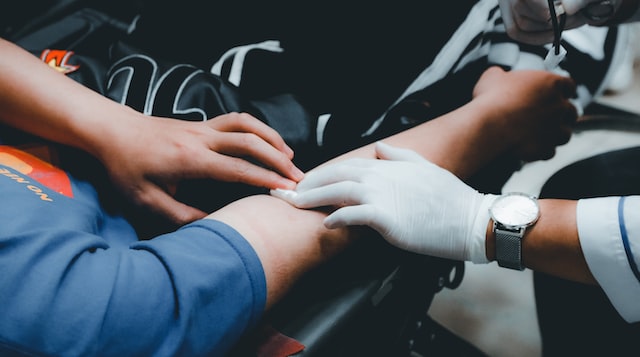
Kay Tobin Lahusen, a prominent gay rights activist whose photographs documented the movement’s earliest days and depicted lesbians who were out when they were virtually absent from popular culture, died on Wednesday morning at a hospital in West Chester, Pa. She was 91.
Her death was confirmed by Malcolm Lazin, a longtime friend and the executive director of the Equality Forum, an L.G.B.T.Q. civil rights group.
Ms. Lahusen and her longtime partner, Barbara Gittings, were at the forefront of the lesbian rights movement, determined to make whom they loved a source of pride rather than shame.
They were early members of the Daughters of Bilitis, the first national lesbian organization, and soon became outspoken about their sexuality and their demands for equality at a time when gay rights groups were less outspoken. They helped organize protests during the 1960s at a National Council of Churches meeting, the Pentagon and the White House, well before the Stonewall uprising in 1969.
They also helped lesbians realize they were not alone by producing The Ladder, a newsletter published by the Daughters that was the first nationally distributed lesbian journal in the United States.
Ms. Gittings was The Ladder’s editor, and Ms. Lahusen became an important contributor, writing under the surname Tobin, which she picked out of the phone book because it was easy to pronounce, unlike Lahusen (pronounced la-HOOZ-en). She also photographed many of the earliest gay rights protests, providing important documentation of a period when many gay activists chose to remain in the closet.
“Occasionally somebody would bring a camera to a picket, but I was the only one who went at it in a sustained way,” Ms. Lahusen said in an interview for this obituary in 2019.
Some of her protest photographs appeared in The Ladder’s inside pages, but the cover still featured illustrations. The vast majority of gay people at the time were closeted, and few wanted their faces appearing in a magazine, let alone on the cover.
“I said, ‘What we really need are some live lesbians,’ and we couldn’t find any,” Ms. Lahusen said.
By the mid-1960s, Ms. Lahusen had persuaded women to pose for cover portraits, including Ernestine Eckstein, an African American lesbian activist who picketed the White House for gay rights in 1965, and Lilli Vincenz, who was discharged from the Women’s Army Corps after she was outed.
In a 1993 interview with Outhistory.org, Ms. Lahusen said her goal had been “taking our minority out from under wraps, and what you might call the normalization of gay.”
As the 1960s wore on, Ms. Lahusen and Ms. Gittings came to believe that the approach taken by the Daughters of Bilitis was too conciliatory, more focused on signaling respectability than fighting for equal rights. “It was all aimed at reforming laggard lesbians,” she said.
They began to work outside of the Daughters, finding common cause with gay rights activists like Franklin Kameny.
Ms. Lahusen helped Mr. Kameny and Ms. Gittings lobby the American Psychiatric Association to remove homosexuality from its list of mental illnesses, in part by persuading a practicing psychiatrist to testify about being gay at the organization’s national convention in Dallas in 1972.
Dr. John E. Fryer addressed the association, under the name Dr. H. Anonymous, wearing a mask and wig to hide his identity so he would not face professional repercussions.
Ms. Lahusen photographed him, fully costumed, with Ms. Gittings and Mr. Kameny, and the next year the association removed homosexuality from the Diagnostic and Statistical Manual for Mental Disorders.
Ms. Lahusen’s photographs offer a rare visual record of the gay rights movement’s earliest days. Many of them are now in the New York Public Library’s archive and were a major part of the 2019 exhibition “Love & Resistance: Stonewall 50,” which celebrated the 50th anniversary of the uprising.
Marcia M. Gallo, a social movement historian and the author of “Different Daughters: A History of the Daughters of Bilitis and the Rise of the Lesbian Rights Movement” (2006), described Ms. Lahusen in an interview as “one of the key foundational organizers and chroniclers of the L.G.B.T.Q. movement from the ‘60s on.”
Ms. Gallo said that Ms. Lahusen was eager to speak about the earliest days of the movement, and that she and Ms. Gittings organized a gay lunch-table group at the care facility where they lived in Kennett Square, Pa.
“She was organizing into her 90s,” Ms. Gallo said.
Katherine Lahusen was born on Jan. 5, 1930, in Cincinnati. She was adopted by her grandparents, Katherine (Walker) and George Lahusen, soon after, and grew up in Cleveland. Her grandfather sold cable for a steel company; her grandmother was a homemaker.
Katherine first realized she was attracted to women when she was barely a teenager, developing crushes on actresses like Katharine Hepburn. It was the 1940s, and many Americans viewed gay people as deviants. But Ms. Lahusen refused to internalize society’s prejudices.
“I decided that I was right and the world was wrong and that there couldn’t be anything wrong with this kind of love,” she was quoted as saying in “Different Daughters.”
She went to a private elementary school and graduated from Withrow High School in Cincinnati in 1948. She followed a girlfriend to Ohio State University, where she majored in English and planned to become a teacher.
Ms. Lahusen graduated in 1952 and moved in with her girlfriend. But the girlfriend soon had second thoughts about their relationship.
“She believed that we couldn’t have a good life together,” Ms. Lahusen said. “She wanted to have a white picket fence and a hubby, and she wanted to have children.”
In the mid-1950s Ms. Lahusen moved to Boston, where she took a job as a researcher at The Christian Science Monitor and struggled to find a companion. She learned of the psychiatrist Richard C. Robertiello, who had written the book “Voyage From Lesbos: The Psychoanalysis of a Female Homosexual” (1959).
“I thought, ‘I don’t want to be cured, but I do want to find out how to meet other lesbians,’” Ms. Lahusen recalled in 2019. “I had the impression there were others in Paris, but I didn’t know any locally.”
She made an appointment with Dr. Robertiello, who showed her a copy of The Ladder. She wrote to the publication and in time met Ms. Gittings, who had founded the New York chapter of the Daughters of Bilitis in 1958.
Ms. Gittings became her partner, and they lived together for decades in Philadelphia, where an apartment they shared early on was honored with a historic marker in 2016.
Ms. Gittings and Ms. Lahusen supported their activism by working different jobs; Ms. Lahusen said she had worked as a waitress and in a music store, among other things. In 1972 she and Randy Wicker published “The Gay Crusaders,” one of the first collections of interviews with prominent gay rights figures.
Ms. Gittings died in 2007, before the Supreme Court legalized same-sex marriage in all of the United States in 2015, so she and Ms. Lahusen never married.
[Read Ms. Gittings’s obituary in The Times]
No immediate family members survive.
Ms. Lahusen said she was overjoyed by how far gay rights had come, but she cautioned young activists against complacency.
“I think some of these advances, as wonderful as they are, are being taken for granted, even now,” she said in 2019. “They need to be codified into law.”







